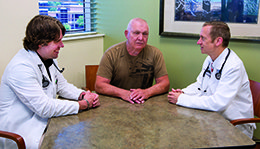Fishing Fan Nets Better Heart Health

Dr. Brock Cookman, left, and Dr. Joseph Kummer, right, follow up with Curt Kiner after his procedure.
Curt Kiner, of Lincoln, is an outdoorsman — and plans to stay that way despite some long-term heart challenges. “One of my great loves in life is fishing,” the 76-year-old says, “and being away from catfishing tournaments for a summer because of my heart problems is not in my plans.”
Curt began seeing doctors at Bryan Heart 10 to 12 years ago, so he is no stranger to cardiology. "In 2008, we learned Curt had a 40 percent blockage in an artery in his heart," Jody said, "but we and the doctors decided the best decision then was to watch and wait, because his symptoms were not that severe. So we returned yearly for his heart checkups.
“In January 2019, Curt began having much worse fatigue and shortness of breath and just felt dead tired. At that point we went to his longtime cardiologist — Joseph Kummer, MD, — to see if this was heart-related.”
Additional tests showed Curt’s artery had by then become completely blocked, leading to his worsening symptoms.
New Skill Set with Interventional Cardiology
Fortunately, interventional cardiologist Brock Cookman, DO, had recently joined Bryan Heart and brought a new set of skills. Dr. Cookman earned his medical degree at Des Moines University. He finished an internal medicine residency at the University of Iowa in Des Moines and a three-year cardiology fellowship at the University of Nebraska Medical Center in Omaha, then received advanced training in interventional cardiology (including complex coronary revascularization procedures) at Aurora St. Luke’s Medical Center in Milwaukee, Wisconsin.
“We found Curt had what is called ‘chronic total occlusion’ or CTO, a complete blockage of an important vessel in his heart," Dr. Cookman said. "Patients with CTO may not have chest pain, but usually do have serious fatigue and shortness of breath. Curt’s cardiologist, Dr. Kummer, collaborated with cardiologist Keith Miller, MD, and me to determine the best approach to his care.”
Dr. Kummer adds, “CTO is a challenging condition, but we were able to really improve Curt’s symptoms because Dr. Cookman’s advanced training in cardiology included particular emphasis on the difficult process of opening heart vessels that are 100 percent blocked.”
Dramatic Picture
Dr. Cookman showed Curt and Jody a dramatic picture of the blocked artery in his heart and made it clear he needed to get it treated very soon. "He said he could improve my symptoms by reopening the artery and explained how he would do that,” Curt said.
For the procedure, Dr. Cookman used specialized wires and a twistable, wire-reinforced catheter to break through the blockage in Curt’s artery, then placed two tiny tubes called stents inside the vessel to keep it open, restoring 100 percent blood flow. Doctors were able to improve the blood supply to Curt’s heart muscle, reducing his tiredness and possibly lowering his risk for abnormal heart rhythms and other problems down the road.
As with many patients at Bryan Heart, Curt’s care was an in-depth team effort.
“Collaboration is one of our great strengths at Bryan Heart,” Dr. Cookman says. “Patients with heart concerns can see any of the Bryan Heart physicians and know that we work together as cardiologists, cardiothoracic and vascular surgeons, and heart rhythm specialists to create the best results for our patients.”
In addition to Dr. Cookman, heart revascularization procedures are performed by cardiologists Dale Hansen, MD, Matt Johnson, MD, Clyde Meckel, MD, and Zach Singsank, DO, based on the complexity of the patient’s needs.
Collaboration Important
“Our collaborative approach is especially important as patients get older because their care may become more complex,” Dr. Cookman says.
Curt and Jody agree that his quality of life improved tremendously after Dr. Cookman did his heart procedure. “Curt can now do many more things, such as walking a mile on the treadmill and climbing stairs, which he couldn’t do before because of fatigue.”
Adds Curt: “I think the procedure Dr. Cookman performed gave me 10 more years of active life. I’m thankful to be here to be with my children and my wife — we’ve been married nearly 60 years — and I’m back to participating in fishing tournaments with my friends. It’s thanks to Dr. Kummer and Dr. Cookman that I’m here.
“I’m so happy I’m alive — and it’s all because of Bryan Heart.”

